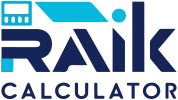What is an APY Calculator?
Unlike simple interest, APY accounts for the effects of compound interest, making it a valuable tool for financial planning.
Why does APY matter? It helps compare different savings accounts and investments to maximize earnings.
How to Use the APY Calculator?
- Step 1: Enter your annual interest rate.
- Step 2: Choose the compounding frequency (daily, monthly, quarterly, annually).
- Step 3: Click “Calculate” to get the Annual Percentage Yield (APY).
Use our Compound Interest Calculator to compare growth over time.
APY Formula
The formula for calculating APY is:
APY = (1 + r/n)n – 1
Where:
- r = Annual interest rate (decimal form)
- n = Number of compounding periods per year
For example, a 5% annual interest rate compounded monthly results in an APY of 5.12%.
Why is APY Important?
- APY shows the **real growth** of your savings or investment.
- It helps compare different savings accounts effectively.
- It provides a better understanding of compounded returns.
APY vs. Interest Rate – What’s the Difference?
| Feature | APY | Interest Rate |
|---|---|---|
| Includes Compounding? | ✅ Yes | ❌ No |
| Higher with Frequent Compounding? | ✅ Yes | ❌ No |
| Best for Comparing Accounts? | ✅ Yes | ❌ No |
Use our Loan Calculator to compare interest rates.
Frequently Asked Questions (FAQs)
What is the difference between APY and APR?
APY includes compounding interest, while APR (Annual Percentage Rate) only represents simple interest.
How does compounding affect APY?
More frequent compounding (daily vs. monthly) results in a **higher APY**, increasing earnings over time.
Which is better: APY or a fixed interest rate?
APY is better because it gives the actual return including compounding.
How can I increase my APY?
Choose savings accounts with high-yield APY and frequent compounding.
Can APY be negative?
No, APY is always positive unless fees reduce your balance.
